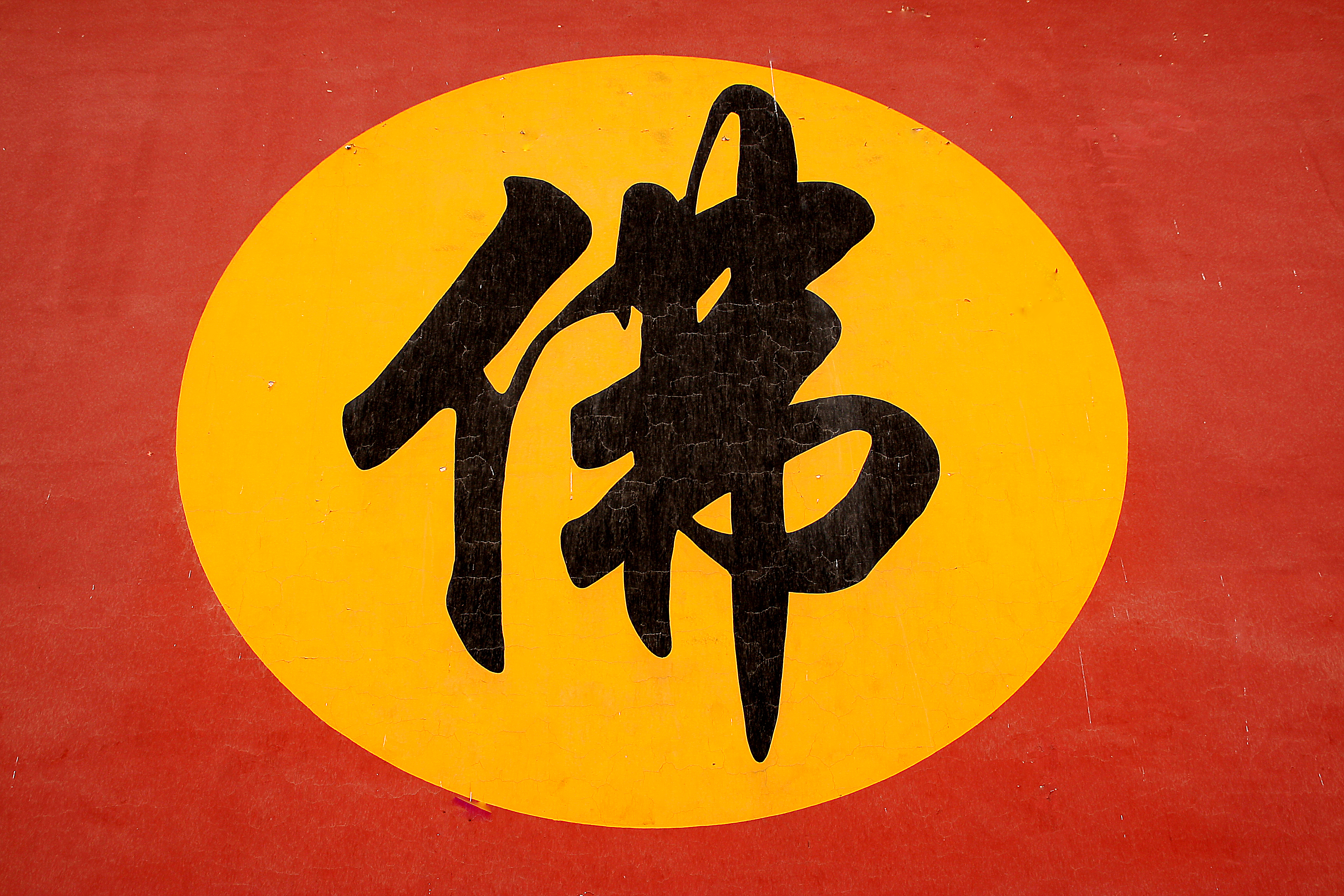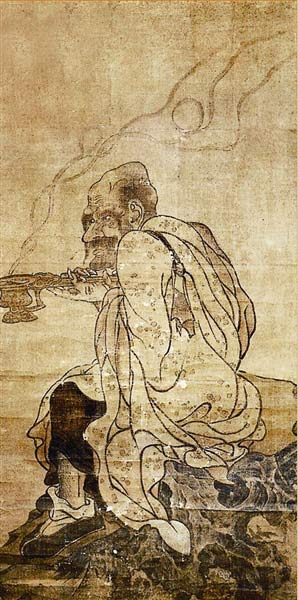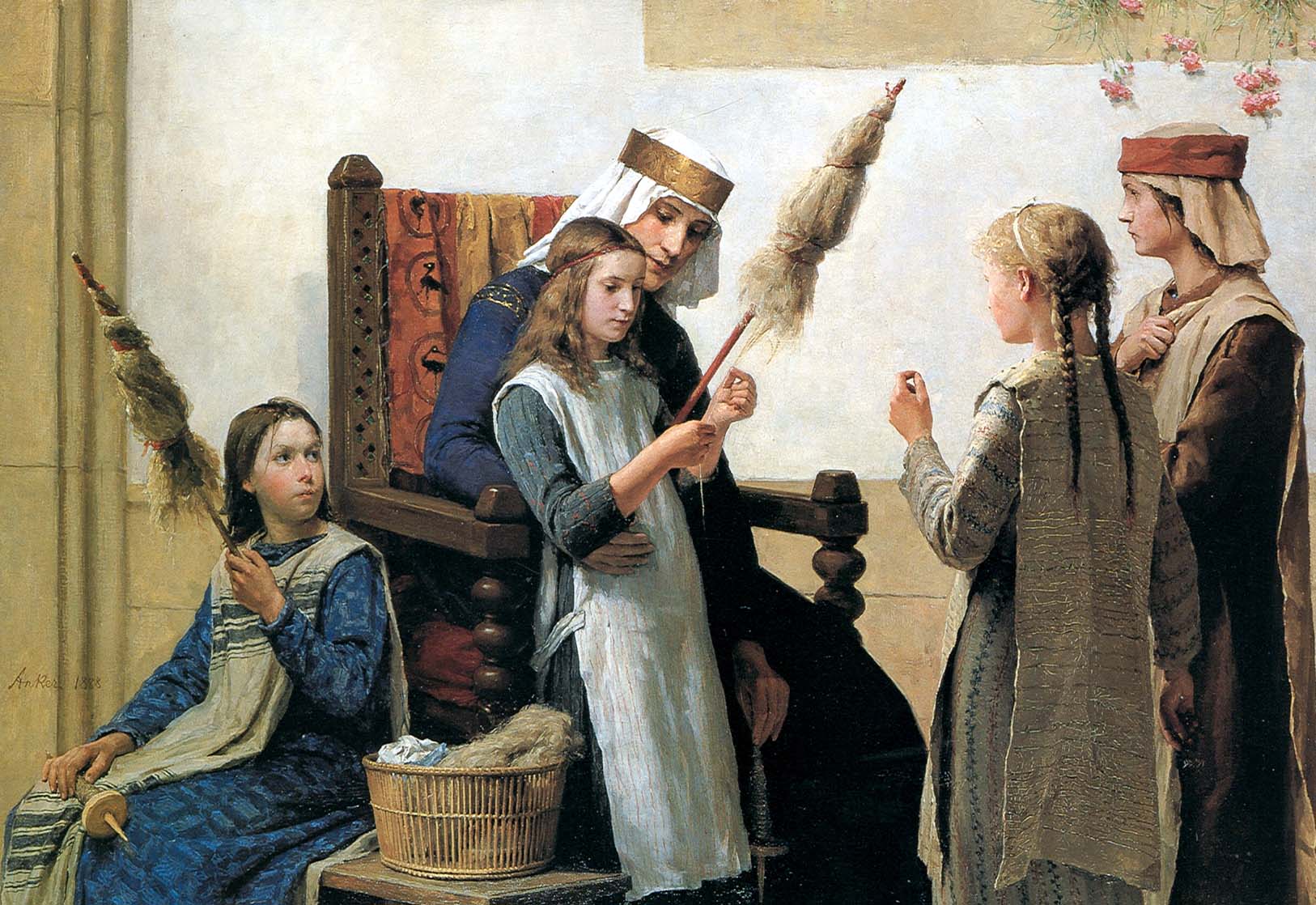|
Qiji (monk)
Qiji (; 863 - 937), also known by his art name Hengyue Shamen (), was a Tang dynasty Chinese Buddhist monk and poet. Qiji wrote more than 852 poems, after Li Bai (701-762), Du Fu (712-770), Bai Juyi (772-846), Yuan Zhen (779-831), he ranks at the fifth position in terms of numbers of poems within the Tang poets. He was one of the big three of Tang dynasty poetmonks (), along with Guanxiu (832-912) and Jiaoran (730-799). Biography Qiji was born Hu Desheng () in 863, in Zuta Village, Weishan Township, Ningxiang, Hunan, to a family of tenant farmers. At the age of 6, he learned writing while grazed cattle for the Tongdu Temple () on the mountain. He took refuge in the Three Jewels (became a monk) under Yangshan Huiji (807-883). As Adult, he went out to study and travelled to Yueyang, Changan, Zhongnan Mountains, Mount Huashan, and Jiangxi. When he returned to Changsha, Xu Dongye (), a poet in the office of Hunan military governor, said: "The poems we write are not good enough. We ... [...More Info...] [...Related Items...] OR: [Wikipedia] [Google] [Baidu] |
Chan Buddhism
Chan (; of ), from Sanskrit '' dhyāna'' (meaning "meditation" or "meditative state"), is a Chinese school of Mahāyāna Buddhism. It developed in China from the 6th century CE onwards, becoming especially popular during the Tang and Song dynasties. Chan is the originating tradition of Zen Buddhism (the Japanese pronunciation of the same character, which is the most commonly used English name for the school). Chan Buddhism spread from China south to Vietnam as Thiền and north to Korea as Seon, and, in the 13th century, east to Japan as Japanese Zen. History The historical records required for a complete, accurate account of early Chan history no longer exist. Periodisation The history of Chan in China can be divided into several periods. Zen, as we know it today, is the result of a long history, with many changes and contingent factors. Each period had different types of Zen, some of which remained influential while others vanished. Ferguson distinguishes three ... [...More Info...] [...Related Items...] OR: [Wikipedia] [Google] [Baidu] |
Guanxiu
Guanxiu () was a celebrated Buddhist monk, painter, poet, and calligrapher. His greatest works date from the Five Dynasties and Ten Kingdoms period. The collapse of the central Tang government in 907, meant artists and craftsmen lost their most powerful patrons. The imperial Tang court had inspired a golden age of literature and art at its apogee. The various provincial courts who claimed to represent a continuation of the tradition of Tang government also claimed continuity in the arts and culture. The state of the Former Shu had acted as the traditional western sanctuary ever since Emperor Xuanzong had sought refuge there during the An Shi Rebellion in 755. By the collapse of the Tang Dynasty something like a miniature Tang court existed at Chengdu. Guanxiu arrived in chengdu in 901, and remained there until his death. Wang Jian, the founding emperor of the Former Shu, bestowed upon him the honorific title Great Master of the Chan Moon (Chanyue dashi), however he is still known ... [...More Info...] [...Related Items...] OR: [Wikipedia] [Google] [Baidu] |
9th-century Chinese Poets
The 9th century was a period from 801 ( DCCCI) through 900 ( CM) in accordance with the Julian calendar. The Carolingian Renaissance and the Viking raids occurred within this period. In the Middle East, the House of Wisdom was founded in Abbasid Baghdad, attracting many scholars to the city. The field of algebra was founded by the Muslim polymath al-Khwarizmi. The most famous Islamic Scholar Ahmad ibn Hanbal was tortured and imprisoned by Abbasid official Ahmad ibn Abi Du'ad during the reign of Abbasid caliph al-Mu'tasim and caliph al-Wathiq. In Southeast Asia, the height of the Mataram Kingdom happened in this century, while Burma would see the establishment of the major kingdom of Pagan. Tang China started the century with the effective rule under Emperor Xianzong and ended the century with the Huang Chao rebellions. While the Maya experienced widespread political collapse in the central Maya region, resulting in internecine warfare, the abandonment of cities, and a ... [...More Info...] [...Related Items...] OR: [Wikipedia] [Google] [Baidu] |
937 Deaths
Year 937 ( CMXXXVII) was a common year starting on Sunday (link will display the full calendar) of the Julian calendar. Events By place Europe * A Hungarian army invades Burgundy, and burns the city of Tournus. Then they go southwards to Italy, pillaging the environs of Naples, Benevento and Monte Cassino. When the Hungarians return home, they are attacked in the Apennine Mountains by Lombard forces, losing their plunder (approximate date). * July 11 – King Rudolph II of Burgundy dies after a 25-year reign, and is succeeded by his 12-year-old son Conrad I ("the Peaceful"). His wife, Queen Bertha, takes effective control of unified Burgundy, transferring its capital to Arles (that Burgundian kingdom was later known from the 12th century as the Kingdom of Arles). * King Otto I refuses to give land to his older (illegitimate) half-brother Thankmar, who gains the support of Eberhard III (duke of Franconia) and Wichmann the Elder, and seizes the fortress of Ere ... [...More Info...] [...Related Items...] OR: [Wikipedia] [Google] [Baidu] |
863 Births
__NOTOC__ Year 863 (Roman numerals, DCCCLXIII) was a common year starting on Friday (link will display the full calendar) of the Julian calendar. Events By place Byzantine Empire * September 3 – Battle of Lalakaon: A Byzantine Empire, Byzantine army confronts an invasion by Muslim forces, led by Umar al-Aqta, Emir of Malatya. The Muslims raid deep into Byzantine territory, reaching the Black Sea coast at the port city of Samsun, Amisos. Petronas annihilates the Arabs near the River Lalakaon, in Paphlagonia (theme), Paphlagonia (modern Turkey). Europe * January 25 – Emperor Louis II of Italy, Louis II claims Provence, after the death of his brother Charles of Provence, Charles. King Lothair II receives Lower Burgundy and a part of the Jura Mountains. * King Louis the German suppresses the revolt of his son Carloman of Bavaria, Carloman (for the second time), who wants a partition (mainly of Bavaria) of the East Francia, East Frankish Kingdom. * Viking raid ... [...More Info...] [...Related Items...] OR: [Wikipedia] [Google] [Baidu] |
Gao Jixing
Gao Jixing (高季興) (858 – January 28, 929), né Gao Jichang (高季昌), known for some time as Zhu Jichang (朱季昌), courtesy name Yisun (貽孫), formally Prince Wuxin of Chu (楚武信王), was the founder of Jingnan, also known as Nanping, one of the states during the Chinese Five Dynasties and Ten Kingdoms period. During Tang Dynasty Background Gao Jichang was born in 858, during the reign of Emperor Xuānzong. He was from Shanshi (陝石, in modern Sanmenxia, Henan), and, in his youth, became a servant of a rich man at Bian Prefecture (汴州, in modern Kaifeng, Henan) — although the identity of his master received divergent reports in traditional sources. According to the '' History of the Five Dynasties'', which the ''Zizhi Tongjian'' also adopted, he became a servant of Li Qilang (), who later became an adoptive son of Zhu Quanzhong the military governor (''Jiedushi'') of Xuanwu Circuit (宣武, headquartered at Bian Prefecture) and had his name changed ... [...More Info...] [...Related Items...] OR: [Wikipedia] [Google] [Baidu] |
Sichuan
Sichuan (; zh, c=, labels=no, ; zh, p=Sìchuān; alternatively romanized as Szechuan or Szechwan; formerly also referred to as "West China" or "Western China" by Protestant missions) is a province in Southwest China occupying most of the Sichuan Basin and the easternmost part of the Tibetan Plateau between the Jinsha River on the west, the Daba Mountains in the north and the Yungui Plateau to the south. Sichuan's capital city is Chengdu. The population of Sichuan stands at 83 million. Sichuan neighbors Qinghai to the northwest, Gansu to the north, Shaanxi to the northeast, Chongqing to the east, Guizhou to the southeast, Yunnan to the south, and the Tibet Autonomous Region to the west. In antiquity, Sichuan was the home of the ancient states of Ba and Shu. Their conquest by Qin strengthened it and paved the way for Qin Shi Huang's unification of China under the Qin dynasty. During the Three Kingdoms era, Liu Bei's state of Shu was based in Sichuan. T ... [...More Info...] [...Related Items...] OR: [Wikipedia] [Google] [Baidu] |
Changsha
Changsha (; ; ; Changshanese pronunciation: (), Standard Mandarin pronunciation: ) is the capital and the largest city of Hunan Province of China. Changsha is the 17th most populous city in China with a population of over 10 million, and the third-most populous city in Central China, located in the lower reaches of Xiang River in northeastern Hunan. Changsha is also called Xingcheng (星城, 'Star City') and was once named Linxiang (临湘), Tanzhou (潭州), Qingyang (青阳) in ancient times. It is also known as Shanshuizhoucheng (山水洲城), with the Xiang River flowing through it, containing Mount Yuelu and Orange Isle. The city forms a part of the Greater Changsha Metropolitan Region along with Zhuzhou and Xiangtan, also known as Changzhutan City Cluster. Greater Changsha was named as one of the 13 emerging mega-cities in China in 2012 by the Economist Intelligence Unit. It is also a National Comprehensive Transportation Hub, and one of the first National ... [...More Info...] [...Related Items...] OR: [Wikipedia] [Google] [Baidu] |
Jiangxi
Jiangxi (; ; formerly romanized as Kiangsi or Chianghsi) is a landlocked province in the east of the People's Republic of China. Its major cities include Nanchang and Jiujiang. Spanning from the banks of the Yangtze river in the north into hillier areas in the south and east, it shares a border with Anhui to the north, Zhejiang to the northeast, Fujian to the east, Guangdong to the south, Hunan to the west, and Hubei to the northwest. The name "Jiangxi" is derived from the circuit administrated under the Tang dynasty in 733, Jiangnanxidao (; Gan: Kongnomsitau). The abbreviation for Jiangxi is "" (; Gan: Gōm), for the Gan River which runs across from the south to the north and flows into the Yangtze River. Jiangxi is also alternately called ''Ganpo Dadi'' () which literally means the "Great Land of Gan and Po". After the fall of the Qing dynasty, Jiangxi became one of the earliest bases for the Communists and many peasants were recruited to join the growing people's rev ... [...More Info...] [...Related Items...] OR: [Wikipedia] [Google] [Baidu] |
Mount Hua
Mount Hua () is a mountain located near the city of Huayin in Shaanxi Province, about east of Xi'an. It is the "Western Mountain" of the Five Great Mountains of China and has a long history of religious significance. Originally classified as having three peaks, in modern times the mountain is classified as five main peaks, the highest of which is the South Peak at . Geography Mount Hua is situated in Huayin City, which is 120 kilometres (about 75 miles) from Xi'an. It is located near the southeast corner of the Ordos Loop section of the Yellow River basin, south of the Wei River valley, at the eastern end of the Qin Mountains, in Southern Shaanxi Province. It is part of the Qinling or Qin Mountains, which divide not only northern and southern Shaanxi, but also China. Summits Traditionally, only the giant plateau with its summits to the south of the peak Wuyun Feng (, Five Cloud Summit) was called Taihua Shan (, Great Flower Mountain). It could only be accessed through ... [...More Info...] [...Related Items...] OR: [Wikipedia] [Google] [Baidu] |
Zhongnan Mountains
The Zhongnan Mountains (), sometimes called the Taiyi Mountains () or Zhounan Mountains (), are a branch of the Qin Mountains located in Shaanxi Province, south of Xi'an, China that extend from Wugong County in the east of the province to Lantian County. At 2604 meters the range's highest point is the Cui Hua Mountain. Other notable peaks and places in the Zhongnan mountains include Lou Guan Tai, (where Taoist sage Laozi is said to have dwelt and conveyed the Dao De Jing), as well as Nan Wutai () and Guifeng (). The Zhongnan mountains have been a popular dwelling-place for Daoist hermits since at least the Qin Dynasty. Buddhist monks began living in the mountains after Buddhism's introduction into China from India in the early first millennium AD. The Complete Perfection Sect, one of the largest branches of modern Taoism, was founded in the Zhongnan mountains by Song Dynasty Taoist Wang Chongyang. Due to the mountains' close proximity to the ancient capital of Chang'an ... [...More Info...] [...Related Items...] OR: [Wikipedia] [Google] [Baidu] |
Changan
Chang'an (; ) is the traditional name of Xi'an. The site had been settled since Neolithic times, during which the Yangshao culture was established in Banpo, in the city's suburbs. Furthermore, in the northern vicinity of modern Xi'an, Qin Shi Huang of the Qin dynasty, China's first emperor, held his imperial court, and constructed his massive mausoleum guarded by the Terracotta Army. From its capital at Xianyang, the Qin dynasty ruled a larger area than either of the preceding dynasties. The imperial city of Chang'an during the Han dynasty was located northwest of today's Xi'an. During the Tang dynasty, the area that came to be known as Chang'an included the area inside the Ming Xi'an fortification, plus some small areas to its east and west, and a substantial part of its southern suburbs. Thus, Tang Chang'an was eight times the size of the Ming Xi'an, which was reconstructed upon the site of the former imperial quarters of the Sui and Tang city. During its heyday, Chang'an ... [...More Info...] [...Related Items...] OR: [Wikipedia] [Google] [Baidu] |








